当前位置:
X-MOL 学术
›
Cryst. Growth Des.
›
论文详情
Our official English website, www.x-mol.net, welcomes your
feedback! (Note: you will need to create a separate account there.)
Bacterial EPS in Agarose Hydrogels Directs Mineral Organization in Calcite Precipitates: Species-Specific Biosignatures of Bacillus subtilis, Mycobacterium phley, Mycobacterium smagmatis, and Pseudomonas putida EPS
Crystal Growth & Design ( IF 3.2 ) Pub Date : 2020-06-17 , DOI: 10.1021/acs.cgd.0c00231 Xiaofei Yin 1 , Florian Weitzel 1 , Erika Griesshaber 1 , Lurdes Fernández-Díaz 2, 3 , Concepcion Jimenez-Lopez 4 , Andreas Ziegler 5 , Alejandro B. Rodriguez-Navarro 6 , Wolfgang W. Schmahl 1
Crystal Growth & Design ( IF 3.2 ) Pub Date : 2020-06-17 , DOI: 10.1021/acs.cgd.0c00231 Xiaofei Yin 1 , Florian Weitzel 1 , Erika Griesshaber 1 , Lurdes Fernández-Díaz 2, 3 , Concepcion Jimenez-Lopez 4 , Andreas Ziegler 5 , Alejandro B. Rodriguez-Navarro 6 , Wolfgang W. Schmahl 1
Affiliation

|
Hydrogels present model systems for biopolymer matrices in biological structural materials, as their fabric and physicochemical properties can be tailored to mimic characteristics of polymer matrices in biological hard tissues. However, hydrogels comprise synthetic compounds and lack attributes of native biopolymers, in contrast to extracellular polymeric substance (EPS) actively secreted by microbes for protection and enhancement of physiological activities. For testing the directing influence of native biopolymers on mineralization, we precipitated calcite/gel composite aggregates from agarose gels containing EPS of Bacillus subtilis, Mycobacterium phley, Mycobacterium smagmatis, or Pseudomonas putida, respectively. We characterized the aggregates with Fourier transform infrared spectroscopy, field-emission scanning electron microscopy imaging, and electron backscatter diffraction. Relative to reference aggregates devoid of EPS, aggregates containing EPS are reduced in size and show distinctive morphologies directed by the EPS of a specific bacterium. In P. putida and M. phley composites, occluded polymers are present as membranes, for M. smagmatis and B. subtilis occluded polymers are mainly developed as networks of fibrils. Precipitate crystal subunit formation in EPS-containing composites is extensive compared to the reference crystal; subunits vary in shape, size, and organization: for M. smagmatis and B. subtilis, subunit organization is radial to spherulitic; for P. putida, it is random; for M. phley, it is coaligned in all three dimensions (single-crystal-like). Bacterial EPS changes mineral microstructure/texture in a species-specific manner, a characteristic that, when developed further, might be used as an identification tool for bacterial calcification in present/past environments.
中文翻译:

EPS细菌在琼脂糖凝胶。指导矿物组织方解石沉淀:物种特异性生物信号枯草芽孢杆菌,结核杆菌phley,分枝杆菌smagmatis和恶臭假单胞菌EPS
水凝胶为生物结构材料中的生物聚合物基质提供了模型系统,因为可以对其织物和理化特性进行定制以模仿生物硬组织中聚合物基质的特性。然而,与由微生物主动分泌的用于保护和增强生理活性的细胞外聚合物(EPS)相反,水凝胶包含合成化合物并且缺乏天然生物聚合物的属性。用于检验关于矿化天然生物聚合物的定向影响,我们沉淀的方解石/凝胶从含的EPS琼脂糖凝胶复合聚集体的枯草芽孢杆菌,结核分枝phley,分枝杆菌smagmatis,或恶臭假单胞菌, 分别。我们用傅立叶变换红外光谱,场发射扫描电子显微镜成像和电子背散射衍射表征了聚集体。相对于不含EPS的参考聚集体,包含EPS的聚集体尺寸减小,并显示出特定细菌的EPS所引导的独特形态。在恶臭假单胞菌和Ph。phley复合物中,闭塞的聚合物以膜的形式存在,因为茎秆分枝杆菌和枯草芽孢杆菌的闭塞聚合物主要发展为原纤维网络。与参考晶体相比,含EPS的复合材料中沉淀晶体亚基的形成更为广泛。亚基的形状,大小和组织各不相同:对于M. magmagisis和枯草芽孢杆菌,亚单位的组织是从径向到球形的;对于恶臭假单胞菌,它是随机的。对于ph。phley,它在所有三个维度(单晶状)上共对齐。细菌EPS以一种特定于物种的方式改变矿物的微观结构/质地,这一特征在进一步发展时可以用作当前/过去环境中细菌钙化的鉴定工具。
更新日期:2020-07-01
中文翻译:

EPS细菌在琼脂糖凝胶。指导矿物组织方解石沉淀:物种特异性生物信号枯草芽孢杆菌,结核杆菌phley,分枝杆菌smagmatis和恶臭假单胞菌EPS
水凝胶为生物结构材料中的生物聚合物基质提供了模型系统,因为可以对其织物和理化特性进行定制以模仿生物硬组织中聚合物基质的特性。然而,与由微生物主动分泌的用于保护和增强生理活性的细胞外聚合物(EPS)相反,水凝胶包含合成化合物并且缺乏天然生物聚合物的属性。用于检验关于矿化天然生物聚合物的定向影响,我们沉淀的方解石/凝胶从含的EPS琼脂糖凝胶复合聚集体的枯草芽孢杆菌,结核分枝phley,分枝杆菌smagmatis,或恶臭假单胞菌, 分别。我们用傅立叶变换红外光谱,场发射扫描电子显微镜成像和电子背散射衍射表征了聚集体。相对于不含EPS的参考聚集体,包含EPS的聚集体尺寸减小,并显示出特定细菌的EPS所引导的独特形态。在恶臭假单胞菌和Ph。phley复合物中,闭塞的聚合物以膜的形式存在,因为茎秆分枝杆菌和枯草芽孢杆菌的闭塞聚合物主要发展为原纤维网络。与参考晶体相比,含EPS的复合材料中沉淀晶体亚基的形成更为广泛。亚基的形状,大小和组织各不相同:对于M. magmagisis和枯草芽孢杆菌,亚单位的组织是从径向到球形的;对于恶臭假单胞菌,它是随机的。对于ph。phley,它在所有三个维度(单晶状)上共对齐。细菌EPS以一种特定于物种的方式改变矿物的微观结构/质地,这一特征在进一步发展时可以用作当前/过去环境中细菌钙化的鉴定工具。











































 京公网安备 11010802027423号
京公网安备 11010802027423号